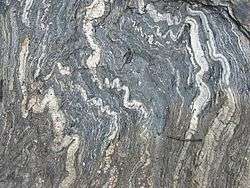Anatexis

Anatexis (via Latin from Greek roots meaning "to melt down") in geology, refers to the differential, or partial, melting of rocks, especially in the forming of metamorphic rocks such as migmatites.[1]
General overview
Optimum temperature conditions for crustal melting
In order to have partial melting in the middle to lower continental crust, the continental geotherm must be steepened towards much higher temperatures. The minimum temperature needed to produce partial melting in metasedimentary rocks is about 650°C. Under these conditions, water saturated metapelites reach their solidus and produce a melt of granite composition. The "standard" geotherm at the Moho is in the 500-600°C range which would not be optimally hot enough for anatectic melting.[2]
Extending the continental geotherm
Situations when the continental geotherm is hotter and can induce partial melting of the crust is where "orogenic processes such as crustal thickening, lithospheric mantle thinning, and underplating of mafic magma" occur[2] (the transfer of heat from magma into the base of the continental crust).[3]
Role of water in production of anatectic melts
The amount of water in granitic systems controls the degree of melting at a given temperature. Very high temperatures are required to generate substantial melt if the water content of the system is low.[2]
Examples of anatexis
Typical examples of anatexis would be the generation of granitic melts (partially melted aluminous crustal rocks), basalts (partially melted mantle peridotite), and migmatitic rock.[4]
Granitic rocks that come from the crust commonly contain xenoliths of metamorphic or sedimentary rocks when pieces of the wall rock are included into the magma during ascent or site of placement.[5]
Although a source of petrologic controversy, migmatites are thought to represent partial melting where melt and residual unmelted material are intertwined in layers (melt segregation).[5] Migmatitic rocks "provide an example of the close relation between metamorphism, deformation, and melt generation and emplacement."[6]
"The Granite Problem" - where igneous and metamorphic petrology overlap
Granites "are undoubtedly the result of extreme fractionation of mantle-derived parental basaltic magma, but it is also possible to derive granite magmas from the melting of metasedimentary and metavolcanic rocks of various compositions in orogenic belts (also called S-type granites)."[5] Two questions that implicate "the granite problem" are:
| “ | ” |
Some in the field of petrology have considered migmatitic terranes as "source areas for magmas, even referring to them as 'baby batholiths.'"[5] Some regard "granitic liquids [that] are produced directly from partial melting of mantle peridotite or subducted oceanic crust [chemically unlikely]; otherwise we should find granitoids in the oceanic lithosphere."[3]
Others have disputed it:
| “ | No direct genetic connection between migmatite formation and larger plutonic masses has ever been established. An increasing number of petrologists who study migmatites now believe that no connection exists and that migmatite formation is an end point of the metamorphic process rather than the beginning of a larger-scale magmatic process. Magmas undoubtedly originate in the deep continental crust, but the nature of their source areas has not been established.[5] | ” |
See also
References
Notes
- ↑ Mervine 2011
- 1 2 3 University of Sydney 2006
- 1 2 Fowler 2005, p. 525
- ↑ Allaby & Allaby 1999
- 1 2 3 4 5 6 7 Blatt, Tracy & Owens 2006, p. 6-7, 15, 184-185, 442-444
- ↑ El Bahariya 2009
Sources
- Allaby, Ailsa; Allaby, Michael (1999). "anatexis". A Dictionary of Earth Sciences. Encyclopedia.com. Retrieved April 2016. Check date values in:
|access-date=(help) - Blatt, H.; Tracy, R. J.; Owens, B. E. (2006). Petrology: Igneous, Sedimentary, and Metamorphic (3rd ed.). W. H. Freeman and Company. ISBN 0-7167-3743-4.
- El Bahariya, Gaafar (2009). "Geology and petrogenesis of Neoproterozoic migmatitic rock association, Hafafit Region, Eastern Desert, Egypt: Implications for syntectonic anatectic migmatites" (PDF). Lithos. 113 (3/4): 465–482. doi:10.1016/j.lithos.2009.06.002. Retrieved April 2016. Check date values in:
|access-date=(help) (Retracted, duplicate publication) - Mervine, Evelyn (August 28, 2011). "Geology Word of the Week: M is for Migmatite". American Geophysical Union Blogosphere. Retrieved April 2016. Check date values in:
|access-date=(help) - Fowler, C. M. R. (2005). The Solid Earth: An Introduction to Global Geophysics (2nd ed.). Cambridge University Press. ISBN 0-521-58409-4.
- "From Segregation, Transport, and Emplacement of Magmas, to the Solid State Deformation of Granitoids: Microstructures, Fabrics, and Finite Strain Fields". University of Sydney, School of Geosciences. 2006. Retrieved December 2009. Check date values in:
|access-date=(help)
